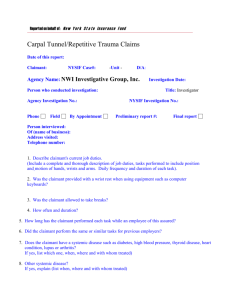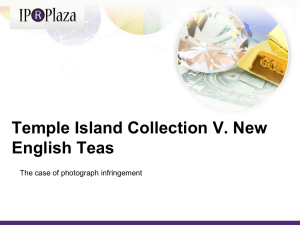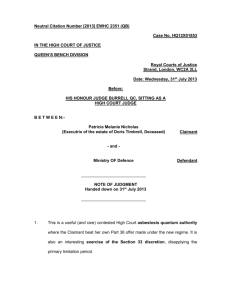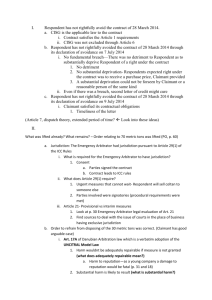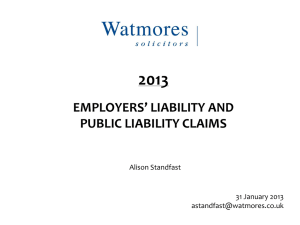Magnesium Electron v Molycorp
advertisement
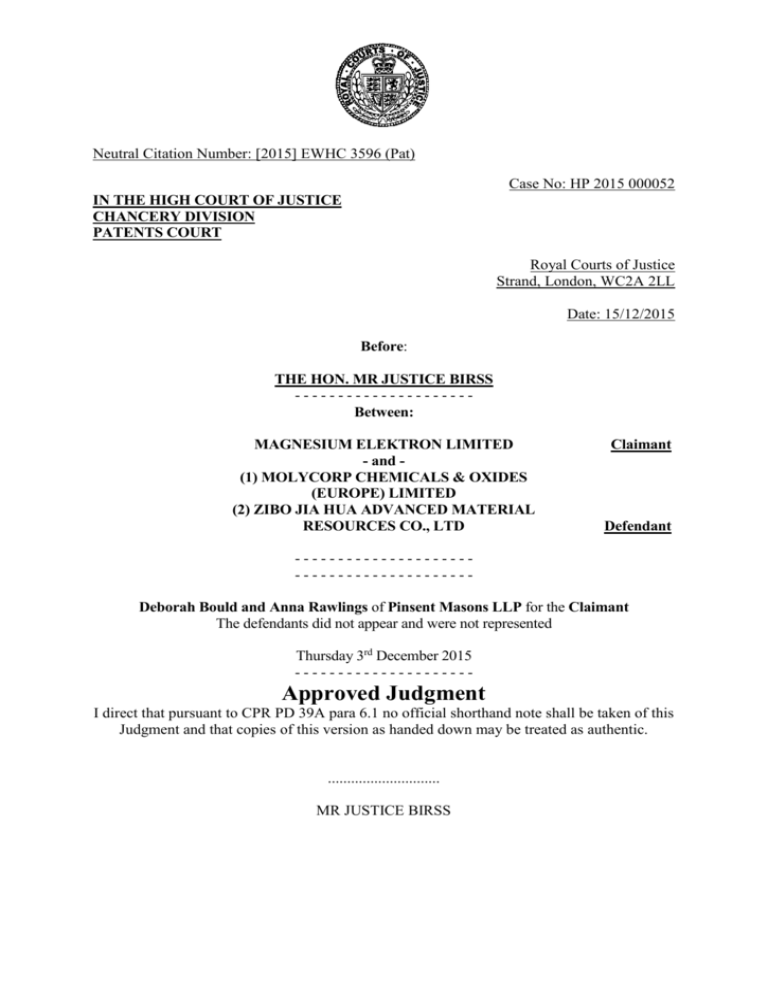
Neutral Citation Number: [2015] EWHC 3596 (Pat) Case No: HP 2015 000052 IN THE HIGH COURT OF JUSTICE CHANCERY DIVISION PATENTS COURT Royal Courts of Justice Strand, London, WC2A 2LL Date: 15/12/2015 Before: THE HON. MR JUSTICE BIRSS --------------------Between: MAGNESIUM ELEKTRON LIMITED - and (1) MOLYCORP CHEMICALS & OXIDES (EUROPE) LIMITED (2) ZIBO JIA HUA ADVANCED MATERIAL RESOURCES CO., LTD Claimant Defendant ----------------------------------------Deborah Bould and Anna Rawlings of Pinsent Masons LLP for the Claimant The defendants did not appear and were not represented Thursday 3rd December 2015 --------------------- Approved Judgment I direct that pursuant to CPR PD 39A para 6.1 no official shorthand note shall be taken of this Judgment and that copies of this version as handed down may be treated as authentic. ............................. MR JUSTICE BIRSS MR JUSTICE BIRSS Approved Judgment Magnesium Electron v Molycorp Mr Justice Birss : 1. This is an application for permission to serve proceedings for patent infringement against a defendant based in China. The action is for infringement of patent EP (UK) 1 444 036 entitled “Process for preparing zirconium-cerium-based mixed oxides”. All the claims are process claims. Claim 1 is as follows: “A process for preparing zirconium-cerium-based mixed oxides which comprises reacting an alkali with an aqueous solution of a soluble zirconium salt containing 0.42-0.7 mole of sulphate anion (SO42–) per mole of zirconium cation at a temperature of not greater than 50°C, in the presence of a soluble cerium salt to form a cerium-zirconium mixed hydroxide, and then calcining the cerium-zirconium mixed hydroxide to form a mixed oxide.” 2. The claimant is based in Manchester and has R&D and manufacturing sites in the UK, USA and Japan. Part of its business is to make and supply rare earth mixed oxide (REMO) products. The claimant’s REMO constitutes mainly zirconium-ceriumbased mixed oxides made by the patented process doped with rare earth oxides such as yttrium oxide. According to the evidence of Peter Moles, an experienced chemist and technical director of the claimant, the patented process is the claimant’s fourth generation process. 3. The first defendant (Molycorp Europe) is a UK company which supplies rare earth mixed oxide (REMO) products. The second defendant (Zibo Jia Hua Advanced Material Resources Co. Ltd (“Zamr”)) of Shandong in China makes zirconiumcerium-based mixed oxides in China. Both defendants are indirect subsidiaries of Molycorp Inc., a US company. In June 2015 Molycorp Inc. petitioned the US Bankruptcy Court for relief under Chapter 11 of Title 11 USC and so, the claimant contends, it is not possible under US law to pursue legal proceedings against it. 4. The claimant’s case is that both defendants have infringed the UK patent in relation to REMO made in China by Zamr using the patented process. I will refer to the defendants’ products as Zamr REMO. The acts of infringement relied on against the first defendant are keeping, using, disposing of and offering to dispose of a product (Zamr REMO) made directly by means of the patented process. The claimant contends that one or other defendant committed the act of importing that product into the UK. The claimant’s case also includes an allegation that the defendants’ acts were carried out pursuant to a common design between them and that accordingly they are jointly liable for any acts of infringement of this UK patent committed by the other. 5. The claimant has issued and served proceedings against the first defendant. Under CPR r6.36, the claimant needs the court’s permission to serve a claim form out of the jurisdiction against Zamr in China. The claimant applied for permission without notice, with the application to be dealt with without a hearing. The application was supported by evidence from Deborah Bould, the claimant’s solicitor. This evidence addressed various potentially relevant “gateways” under PD 6B paragraph 3.1, which I will return to, but it did not address the underlying merits of the claim. I invited the claimant to consider this. As a result the claimant filed the witness statement of Mr Moles and the matter was dealt with at a short hearing. At the hearing the claimant Magnesium Electron v Molycorp MR JUSTICE BIRSS Approved Judgment was ably represented with the court’s permission by its solicitor Deborah Bould and Anna Rawlings of Pinsent Masons. 6. The claimant submitted that there were issues to be addressed: i) Is there a serious issue to be tried? ii) Is there a good arguable case that whichever of the gateways in PD 6B paragraph 3.1 are relied on by the claimant are satisfied? iii) Is England and Wales is a proper place in which to bring the claim? 7. This way of putting the issues provides a convenient framework within which to consider the relevant matters. 8. Since the application is made without notice to the defendants the claimant accepted that it had a duty of full and frank disclosure to the court. Serious issue to be tried 9. Based on De Molestina v Ponton [2002] 1 Lloyds Rep 271, the claimant submitted that the serious issue to be tried test for service out of the jurisdiction on the merits (Seaconstar v Bank Markazi Jomhouri Islam Iran [1994] 1 AC 438) was the same as the test for resisting summary judgment (CPR Part 24) or striking out (CPR Part 3 r3.4). I accept that submission but for reasons which will emerge below, it is also necessary to consider the higher hurdle of good arguable case (see below) which is applicable to establishing jurisdiction. 10. Section 60(1)(c) of the Patents Act 1977 provides as follows: “60.— Meaning of infringement. (1) Subject to the provisions of this section, a person infringes a patent for an invention if, but only if, while the patent is in force, he does any of the following things in the United Kingdom in relation to the invention without the consent of the proprietor of the patent, that is to say— … (c) where the invention is a process, he disposes of, offers to dispose of, uses or imports any product obtained directly by means of that process or keeps any such product whether for disposal or otherwise.” 11. In the light of the provisions of the Patents Act there are two distinct questions which need to be addressed. One is whether Zamr has committed any relevant acts relating to Zamr REMO. The other is whether Zamr REMO is a product made directly by the patented process. Both questions need to be answered to satisfy the relevant merits test. MR JUSTICE BIRSS Approved Judgment Magnesium Electron v Molycorp 12. Turning to the first question, the evidence in Ms Bould’s witness statement sets out details of a consignment of Zamr REMO supplied by Molycorp Europe to a company in North Wales. The documents in evidence are a Zamr packing list dated 17th August 2015 for a 250kg shipment from China to Heathrow bearing a Zamr stamp which includes the words “Import & Export”, a Zamr certificate of analysis dated 16th July 2015 and Molycorp Europe delivery note for the 250 kg consignment to the North Wales company. The batch number on the delivery note matches the lot number on the certificate. These documents link the Chinese defendant Zamr to the act of importation of the goods into London Heathrow and there is a serious issue to be tried as to the pleaded allegation that it was Zamr which committed the act of importation into the UK. However, while one or other of Zamr or Molycorp Europe must have imported the goods into the UK, there is no evidence which makes the claim that Zamr did that any better than the claim that it was Molycorp Europe. I am not satisfied on this evidence that the higher, good arguable case, test is satisfied in relation to the act of importation by Zamr. 13. The claimant also pleads an allegation that Zamr and Molycorp Europe are liable as joint tortfeasors on the basis of a common design. 14. In Sandvik v Kennametal [2010] EWHC 3417 (Pat) Arnold J considered an application to set aside service out of the jurisdiction on a foreign defendant in a patent case in which the claim against the foreign defendant was based on joint tortfeasance. In considering this question, the judge applied the higher hurdle of good arguable case which derives from the judgment of Waller LJ in Canada Trust v Stolzenberg (No 2) [1998] 1 WLR 547 (CA). He also noted the observations made by Laddie J in Napp v Asta [1999] FSR 370 about the particular considerations raised by reliance on a claim of joint tortfeasance as the basis for bringing a foreign defendant into a claim for infringement of a UK intellectual property right. The observations were: “… but the earlier cases illustrate that the court is careful to ensure that foreign defendants are not brought unnecessarily into English proceedings, and that the courts therefore look carefully at allegations of joint tortfeasance to see whether there is anything of substance in them. In case after case it has been said that the mere fact that a company is a parent company of a subsidiary which is a primary infringer does not make the parent itself an infringer. The fact that one company owns a trade mark which another infringing company uses on infringing goods does not make the trade mark owner an infringer. At all times the courts are looking to see whether there is a credible case made out that the joint tortfeasor has really become involved in some way with the tort in the jurisdiction which is the subject of the action.” (Laddie J at 375) 15. I agree with those observations. Like Arnold J, it seems to me that the right approach to considering the merits of a claim to join a foreign defendant into English patent proceedings on the basis of an allegation of joint tortfeasance is to apply the good arguable case hurdle to that aspect of the claim. That is because that higher hurdle is concerned with establishing jurisdiction. MR JUSTICE BIRSS Approved Judgment Magnesium Electron v Molycorp 16. In relation to a common design between two companies in a group in which one company is a foreign company making the product overseas and the other company is a UK company selling that product in the UK, the claimant relied on Aubrey Max Sandman v Panasonic [1998] FSR 651. In that case Pumfrey J (as he then was) refused to set aside service out of the jurisdiction on the foreign manufacturer based on an allegation of common design. This was on the basis that merely facilitating the commission of a tort was not enough, one needs to show that the foreign company did more than look on with approval at the acts of the UK company. The critical element before Pumfrey J was that the foreign company, in making the articles abroad, had specifically adapted them for sale in the UK. Before Pumfrey J the foreign company was the parent of the UK company whereas in this case the corporate relationship between Zamr and Molycorp Europe is different but that does not matter. 17. The point relied on by the claimant before me is that the Zamr certificate of analysis (in English and Chinese) which was sent to the customer in North Wales explains how the product matches the customer’s specification, and therefore supports an inference that the product was supplied by Zamr to meet the requirements of the customer in the UK. I agree. There is a good arguable case that Zamr is liable as a joint tortfeasor with Molycorp Europe for the acts committed in the UK by Molycorp Europe, in particular the disposal of the goods to that customer. 18. The second question is more involved. The claimant believes that the Molycorp REMO is made using the patented process but the problem faced by the claimant is how to prove it. This can be difficult (for an example of some of the difficulties see e.g. Nutrinova v Scanchem [2001] FSR 42). 19. For the purposes of this application the claimant relies on the witness statement of Mr Moles. He explains that the REMO products in issue are used in a process called washcoating in which active materials, including REMO, are washcoated onto a ceramic substrate for use in automotive emissions catalysts. Once coated onto the catalyst the active washcoat is intended to deliver emission gas conversion which meets the legislation limits and takes into account the specific engine management characteristics of the vehicle. The job of the claimant’s REMO is to deliver oxygen when needed, constantly taking oxygen from the atmosphere when the air/fuel mixture is lean (low in fuel, high in air) and conversely releasing oxygen when the air/fuel mixture is rich (high in fuel, low in air). 20. The claimant has arranged for a sample of the product supplied to the North Wales customer to be taken and analysed. Part of the sample was calcined to remove water and adsorbed carbon dioxide. A sample of the calcined material was sent for analysis by two professors in Cyprus and Greece, Professor Efstathiou and Professor Boghosian respectively. The remainder of the sample (some calcined and a portion which had not been calcined) has been analysed in the claimant’s own spectrographic laboratory. Certain techniques were used to confirm that the samples match the Zamr certificate of analysis. They were Multipoint Specific Surface Area measurements, Powder X-ray Diffraction and X-ray fluorescence. 21. Mr Moles explains that the claimant has been working with the professors to develop experiments which identify what he refers to as a chemical fingerprint of REMO obtained directly by means of the patented process. The claimant says it has found that the patented process give the REMO produced by that method a unique MR JUSTICE BIRSS Approved Judgment Magnesium Electron v Molycorp nanostructure which in turn provides enhanced oxygen release kinetics. The nanostructure is identified by Raman spectroscopy and the oxygen release kinetics are identified by two techniques: Hydrogen Transient Isothermal Reduction (H2TIR) and Transient Isothermal Isotopic Exchange (16O/18O). Draft protocols for these three experiments are exhibited by Mr Moles. The Raman spectroscopy reveals information about the physical bulk structure of the metal oxide solids focussing on the oxygen sub-lattice, H2TIR evaluates the concentration of labile lattice oxygen removed from the metal oxide and the oxygen isotope technique probes the mobility of surface and bulk oxygen of the oxygen sub-lattice of the metal oxide. 22. Carrying out the full experiments is a major project and is taking time to complete. The samples tested so far are (i) a sample from the trap purchase (“TP1”), (ii) two samples both made by the patented process (S1 and S2), and (iii) a control sample (S8). Samples S1 and S2 differ in that while both are made by the patented method, S1 was made especially for the experiments while S2 was taken from a batch of commercial product. The control sample S8 was made by the claimant’s previous, first generation process. There are other products mentioned in the exhibit (S3 to S7) but no results have been produced in evidence for them. 23. Mr Moles has discussed the initial results with Professor Efstathiou and Professor Boghosian. They have told him that TP1 behaves almost identically to S1 and S2 and that all these three samples behave very differently from S8. The full written report is not yet available and will be produced in mid-January 2016 once all the data has been captured. Mr Moles states that: “The experiments on the trap purchase show that the second defendant’s REMO has identical characteristics in terms of nanostructure and kinetics and therefore I believe that they must have been produced by the Patented process for I know of no other process which could produce such results.” 24. The claimant’s case is advanced on two bases. The first basis is the submission that this evidence demonstrates that there is a serious issue to be tried as to whether the Zamr REMO is an infringing product under s60(1)(c) of the 1977 Act. I accept that submission. Mr Moles’ explanation of the techniques is brief and his evidence is conclusory in part. Nevertheless the experimental techniques on which the evidence is based are set out in detail in the protocols and overall the evidence is clear and makes sense in the context of the patent. His evidence about the results is preliminary and based only on what he has been told by the two Professors but there is no reason not to take that evidence at face value. 25. The second basis on which the claimant advances its case is by relying on s100 of the Patents Act, which provides as follows: 100.— Burden of proof in certain cases. (1) If the invention for which a patent is granted is a process for obtaining a new product, the same product produced by a person other than the proprietor of the patent or a licensee of his shall, unless the contrary is proved, be taken in any proceedings to have been obtained by that process. MR JUSTICE BIRSS Approved Judgment Magnesium Electron v Molycorp (2) In considering whether a party has discharged the burden imposed upon him by this section, the court shall not require him to disclose any manufacturing or commercial secrets if it appears to the court that it would be unreasonable to do so. 26. The argument is that the fact TP1 product behaves almost identically to S1 and S2 shows that they are in the relevant respects “the same product” while the evidence (i) that all three behave differently from the control sample S8 made by the previous process, and (ii) that Mr Moles knows of no other process which could produce such results, together establishes that the process is “a process for obtaining a new product”. 27. If sections in the Patents Act could ever be described as notorious then this may be the one. In Generics v Lundbeck [2006] EWCA Civ 1261 its interpretation was described as difficult (per Jacob LJ paragraph 8). In Crystal Fibres v Fianum [2009] EWHC 2149 (Pat) it was described as difficult to construe and apparently quite narrow (per Floyd J as he then was, paragraph 24). These are the only cases the claimant’s lawyers were able to find which addressed the section. Neither of them had to address what the section actually means. 28. It is clear that s100 was passed to give effect to Art 35 of the Community Patent Convention, which uses essentially the same language. It is also reasonably clear that the section is supposed to meet the UK’s obligation to comply with Art 34(1) of TRIPS and, in that context, by complying with option (a) (see Art 34(2)). 29. The key question of interpretation of s100 is - what is a process for obtaining new product? 30. The word “new” in s100 must mean the same thing as in sections 1(1)(a) and 2(1) of the same act. In other words the product must be novel. But what is it that has to be novel? The section refers to a “new product”. The product which has to be a “new product” is the product made by the process. If one turns to claim 1, that claim claims a process for making “zirconium-cerium-based mixed oxides” but the patent makes it clear that such a product, described in that way, is not new. Paragraph [0002] of the patent recognises that zirconium-cerium-based mixed oxides were known in the prior art. So a claim simply to “zirconium-cerium-based mixed oxide” would not be novel, i.e. not new. Moreover if a product defined in that general way was novel, then the inventor would have been able to claim it, the patent would most likely contain a product claim as well as process claims, and the problem faced by the claimant in this case would not arise. But approached that way the problem faced by s100 would never arise either. If that is what “new product” means in s100 then the section is pointless. This is one way of explaining the difficulty referred to in the earlier cases. 31. In my judgment that is not what “new product” means. There is nothing in the section which requires that the product which must be a new product is a thing defined in the same level of generality as the words used in the process claim. This case illustrates the difference. The claimant says the preliminary results establish that products made by the patented process have a particular fingerprint which is unique to that process. The fact that products with that fingerprint are produced by that process and no other process known to Mr Moles is what the claimant contends means that the patented process satisfies s100. The products produced by that process are novel. They have MR JUSTICE BIRSS Approved Judgment Magnesium Electron v Molycorp not been made available to the public before. The fact that the patent does not assert that products made that way have a unique fingerprint does not matter. In my judgment that is the right way to approach the section. 32. The Zamr REMO is the same product as the new product produced by the process because (says the claimant) it has the same characteristics which make the product new. It is not the same product because it consists of zirconium-cerium-based mixed oxides, it is the same product because it has the same fingerprint. That fingerprint is what makes the products obtained by the process new. 33. Neither of the two bases on which the claimant puts its case are mentioned in the Particulars of Infringement but nothing turns on that. Particulars of Infringement in the Patents Court (as opposed to the IPEC) do not conventionally address that sort of issue in that way. Moreover the claimant anticipates that a Product and Process Description will be served in the proceedings (or disclosure will be given) and there may be no need to rely on these indirect approaches at all. 34. In conclusion on the merits, there is a serious issue to be tried that Zamr REMO is a product obtained directly by means of the patented process. There is a serious issue to be tried that Zamr imported that product into the UK and there is a good arguable case that Zamr is liable as a joint tortfeasor for the acts which have been carried out by Molycorp Europe in the UK, such as supply of the Zamr REMO to the customer in North Wales. The jurisdictional gateways 35. For any given gateway relied on to establish jurisdiction, the claimant must establish a good arguable case. The claimant submitted that this is a higher standard than a serious issue to be tried or real prospect of success but not as high as proof on the balance of probabilities (citing Canada Trust (above)). That test reflects the requirement that on the material available the party seeking to serve out of the jurisdiction should have a much better argument than the other. The claimant also referred to the recent judgment of the Court of Appeal in Erste Group v JSC “VMZ Red October” [2015] EWCA Civ 379 which I will mention in context. 36. The gateways relied on are 6B 3.1(2) (a claim for an injunction to refrain from doing an act within the jurisdiction) and 6B 3.1(3) (necessary and proper party) and paragraph 6B 3.1(9)(b) (claim in tort). 37. Turning to the injunction gateway (6B 3.1 (2)), it is as follows: “A claim is made for an injunction ordering the defendant to do or refrain from doing an act within the jurisdiction.” 38. The claimant referred to Rosler v Hilbery [1925] Ch 250 and Watson v Daily Record [1907 1 KB 853. Those cases show that the discretion to give permission to serve out based on this gateway requires the claimant to establish that the injunction to restrain acts in the UK is a genuine aspect of the relief sought and that there is a reasonable prospect of an injunction being granted given that it is itself a discretionary remedy. There is no difficulty about that in this case. An injunction restraining patent infringement is often the most important remedy sought by a patentee. It is a genuine MR JUSTICE BIRSS Approved Judgment Magnesium Electron v Molycorp part of the relief claimed by the claimant here. Equally while the Patents Court always retains a discretion whether or not to grant an injunction following a finding of infringement and it may exercise that discretion for example by delaying the final injunction in some cases, it is very rare for such an injunction to be refused altogether. I am satisfied that this gateway is established to the relevant standard both in relation to the claim based on importation and the claim based on joint tortfeasance. 39. The next gateway is PD 6B 3.1(3), as follows: (3) A claim is made against a person (‘the defendant’) on whom the claim form has been or will be served (otherwise than in reliance on this paragraph) and – (a) there is between the claimant and the defendant a real issue which it is reasonable for the court to try; and (b) the claimant wishes to serve the claim form on another person who is a necessary or proper party to that claim 40. In the application of this gateway “the defendant” is Molycorp Europe and the other person is Zamr. This gateway was considered by the Court of Appeal in Erste. The first limb of the test requires two things – there must be a real issue between the claimant and the defendant and it must be reasonable for the court to try that issue. That test is satisfied in this case. There is a real issue between the claimant and Molycorp Europe arising from its supply of Zamr REMO in the UK. The issue is a claim for UK patent infringement. It is plainly reasonable for the Patents Court to try that issue. 41. Turning to the second limb, I will consider whether Zamr is a proper party to the claim. The claimant relied on Electric Furnace v Selas [1987] RPC 23. That case establishes that in the context of leave to serve out of the jurisdiction on this ground, if a claimant has a good cause of action for damages against two defendants, one local and one outside the jurisdiction, obtaining judgment in this country against the foreign defendant as well the local defendant enabled the claimant to choose against which of the defendants to enforce his judgment and was of potential advantage to the claimant. This applies in the present case. The claimant also submitted that the claims against the two defendants were inextricably linked. I agree. If both Zamr and Molycorp Europe had been within the jurisdiction, then they would both have been joined into a single action. I am satisfied that this gateway is established for both importation and joint tortfeasance. 42. Turning to the tort gateway (6B 3.1(9)), it is as follows: “(9) A claim is made in tort where – (a) damage was sustained, or will be sustained, within the jurisdiction; or (b) damage which has been or will be sustained results from an act committed, or likely to be committed, within the jurisdiction.” MR JUSTICE BIRSS Approved Judgment Magnesium Electron v Molycorp 43. An important issue in the Erste case was about what sort of alleged damage can satisfy the gateway. This turned on what the reference to damage sustained in the jurisdiction meant in this gateway. In fact the gateway has been amended since Erste but not in a manner which makes any difference to the issue. The court regarded as very attractive a submission that the damage referred to was “the damage” in the sense of Art 5(3) of the Judgments Regulation rather than just any damage but decided (paragraphs 101-108) that it was not necessary to overrule a series of first instance decisions which had given the gateway a wide effect on that latter basis although the court clearly doubted that those decisions were right. The court in Erste held that the alleged damage relied on in the case before it, which was merely a reflective consequence of damage sustained in New York, did not satisfy the gateway. 44. The difficulty in Erste does not arise in this case. The primary and direct damage caused by infringement of a UK patent is damage sustained within this jurisdiction. The patent is a UK patent and the monopoly is territorial. Furthermore if the acts are repeated, then damage will be sustained within the jurisdiction. Considering the particular circumstances of this case, if the Zamr REMO is infringing, then the acts of importation and sale of that product have invaded the patented UK monopoly. Even if the sales have not caused lost sales to the patentee, the patentee will have lost a sum equal to a reasonable royalty. That would satisfy 3.1(9)(a). 45. Moreover since proof of damage is not a necessary ingredient for the cause of action of patent infringement, it is not necessary in order to satisfy this limb of the gateway to apply the higher standard of good arguable case to the merits of the issue of infringement (see Hamblen J as he then was in Cecil v Bayat [2010] EWHC 641 (Comm) in which he considered the difference between the two). That means that the question whether the Zamr REMO is a product obtained directly by means of the process and the issue of importation only have to satisfy the serious issue to be tried test, which they do. I have already dealt with the test to be applied to joint tortfeasance in any event. 46. However the claimant did not advance its case based on 3.1(9)(a), rather it relied on 3.1(9)(b). The application of that latter gateway is different from 3.1(9)(a) since 3.1(9)(b) includes, as a basis for jurisdiction, an act committed within the jurisdiction. In relation to the joint tortfeasance aspect of the case, there is no difficulty. The acts committed in the UK which the claimant relies on are the acts of Molycorp Europe for which Zamr is said to be jointly liable. The joint tortfeasance claim discloses a good arguable case and I will give leave on that ground in relation to that claim. 47. On the other hand, I am not satisfied that the gateway based on 3.1(9)(b) is made out to the relevant standard for the claim based on importation. In relation to that claim it seems to me that the act within the jurisdiction which the gateway refers to has to be the act of importation itself. However while there is a serious issue to be tried that Zamr was the importer and so has committed an act of within the jurisdiction, this is not a much better argument than the argument that Molycorp Europe imported the goods. The material is not sufficient to satisfy a higher hurdle and I will not give leave under this gateway for that claim. 48. The problem concerning 3.1(9)(b) only occurred to me after I had heard the application and indicated I would make the order with detailed reasons to follow later. For that reason I have considered 3.1(9)(a) even though it was not addressed. I am MR JUSTICE BIRSS Approved Judgment Magnesium Electron v Molycorp satisfied that I should give permission to serve out on the tort gateway under 3.1(9)(a) for both importation and joint tortfeasance and under 3.1(9)(b) for joint tortfeasance. Appropriate forum 49. The court will not give permission unless it is satisfied that England and Wales is a proper place in which to bring the claim (CPR r6.37(3) and see e.g. Spiliada v Consulex [1987] AC 460). This can be dealt with shortly since England and Wales is plainly the proper place to bring this claim. The claim is for infringement of a UK patent, involving supply of goods to a company in Wales. The applicable law is English law. Furthermore, if validity is put in issue (as one would expect in due course) then the case would be within the exclusive jurisdiction of the court. Conclusion 50. I will give permission to serve this claim on Zamr in China.


